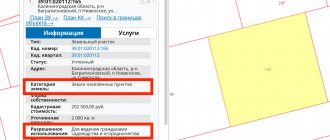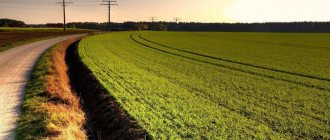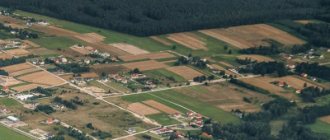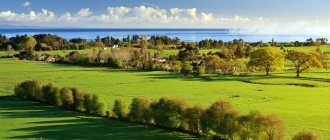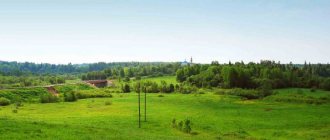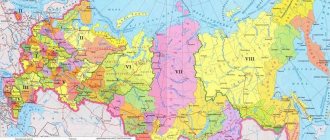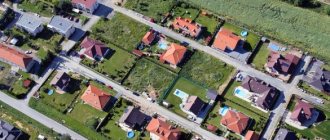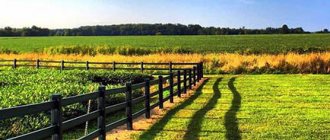Agricultural activity is inextricably linked with the use of land for agricultural purposes. The plot can be owned or long-term leased, but you need to know the intended purpose of the land, which is subject to a certain type of classification of permitted use. This will determine what activities are not prohibited from being carried out on a particular piece of land in order to avoid unpleasant misunderstandings.
Agricultural lands are areas and territories of all settlement boundaries used for agricultural needs or similar purposes. Unlike lands for agricultural use, they are intended for the full cycle of growing and processing products. This makes it possible to build warehouses there to store products collected from the fields, as well as organize the necessary infrastructure.
Land Code of the Russian Federation
Regarding agricultural land, the following regulatory framework is used:
- The concept and purpose of land is given in the Land Code of the Russian Federation, art. 77. It is indicated here that this category of land is intended for farming, processing, growing and storing products. Therefore, the construction of appropriate buildings is allowed.
- Legal regulation of the issue of turnover of agricultural land is carried out in accordance with the norms of Federal Law No. 101. It establishes legal relations regarding the disposal and use of lands of this category, and also establishes a number of restrictions regarding their turnover.
The concept of rational land use
In relation to agricultural lands and especially fertile lands, the problems of rational land use are relevant. It should not deplete the soil, but, on the contrary, contribute to the preservation and enhancement of land resources of the agro-industrial complex. Key ideas of rational land use:
- lands should be used in the most natural way possible for them;
- maximum yields are limited by potential fertility and can be increased artificially solely through soil depletion;
- it is necessary to maintain an optimal balance of arable land, hayfields and pastures;
- forest belts and other protective plantings must be preserved and restored;
- Industrial and other non-agricultural uses of agricultural land should be minimized.
During the Soviet period, rational land use was ensured by a planned economy. Collective and state farms were large agricultural producers, provided with seed, equipment and fertilizers of adequate quality.
The regime of land exploitation was more gentle and scientifically based. In modern Russia, areas of agricultural land have been crushed, which makes it difficult to change crops, carry out reclamation work, control pests and implement other appropriate measures.
Tenants, being temporary workers and not permanent owners of land, are interested in maximizing profits regardless of the deterioration of soil quality. The list of problems can be continued. One thing is obvious: the system of rational land use in the Russian Federation is just being formed.
Categories of land and types of permitted use in the 2021 table
Agricultural land plots are all land that can be transferred to both legal entities and individuals for the following purposes:
- development, cultivation and processing of agricultural products;
- creation of infrastructure for the full cycle of agricultural production;
- conducting research activities for scientific and educational purposes.
Lands and allotments include the following categories of land:
- arable land;
- land for mowing and haymaking;
- pasture;
- forest belt, with the exception of the forest fund;
- allotment occupied by courtyards and outbuildings;
- land under perennial plantings.
It should be noted that land suitable for this purpose is allocated for agriculture. And for industrial facilities and other purposes, less valuable and fertile lands are allocated, not intended for agricultural work.
All lands are divided into categories of permitted use. We present the information in table form.
| Land categories | Composition of permitted use |
| Suitable for farming | All land plots located outside the boundaries of settlements |
| For agricultural production | Plots for arable land, grazing, haymaking, as well as land for perennial crops and vineyards |
| Private household plot (personal subsidiary plot) | Allotments related to household plots and field plots |
| Gardening and horticulture | Provided to individuals for planting and growing fruit trees, berry plants, as well as vegetables and melons |
| Country house management | Lost force at the beginning of 2021. |
| Land for haymaking, pastures, livestock | Agricultural plots for the purposes of grazing livestock, stockpiling feed, raising animals |
| Organization and management of peasant farming | Land is allocated for already registered legal entities listed as peasant or farm enterprises |
| Land under various agricultural buildings | Allotments with buildings located on them, which are necessary for the production cycle and storage of products grown and collected from the fields |
| Lands for objects of other purposes, not related to agriculture | Areas that are of less fertile quality, suitable for industrial construction, laying highways and pipelines |
| Protective forest belts | Land is used for planting trees |
| Other agricultural lands | Areas used for teaching and research activities |
Also read: VRI classifier of a land plot, compiled in a table and with all changes in 2021.
What you are allowed to do
What agricultural activities are allowed?
Legislative acts establish that agricultural areas can be used for the following purposes:
- Production of raw materials and agricultural products.
- Personal farming.
- Gardening device.
- Fish farming.
- Creation of a farm.
Legislative acts do not regulate issues regarding the construction of any buildings on agricultural land. But to run a full-fledged economy, some facilities will be necessary. Therefore, the following may be found in the area:
- Cowsheds.
- Chicken coops.
- Roads.
- Garages.
- Warehouses.
- Sheds.
Construction of a residential building is a complex but possible process. In order for a house or cottage to be built absolutely legally, certain conditions will need to be met.
Is it permissible to build houses or other buildings?
Legislation allows the construction of only the following buildings on agricultural land:
- Warehouses or cellars for storing crops or preparations.
- A house for personal use or for housekeeping.
- Country summer house.
- Outbuildings.
- Single-family cottage with less than three floors.
Construction is allowed only on territories that are the property of an individual. Only after receiving ownership of the land can you proceed to the procedure for obtaining a special construction permit, which will be based on a pre-developed building design. Only with such permission can the building be registered after completion of construction work.
Stock
Is it possible to build a house on agricultural land for gardening and private farming?
Let us clarify that for a number of agricultural lands that can be taken by citizens on a long-term lease or purchased as their own, it is possible to build residential buildings.
Since 2021, the definition of “dacha” has ceased to exist. Now dacha construction is moving into garden construction.
| Categories of land by purpose | Types of permitted use | |||
| Gardening | Horticulture | Personal farming | individual housing construction | |
| 1.5, 13.2 | 13.1 | 1.16 | 2.1 | |
| Agricultural land | You can grow crops “for yourself”, you can build housing, but the right to register is not provided for. | Construction of only temporary and not permanent structures. You can't register. | Agricultural crops and a garden are grown on the site. Permission to build on the land is not required. It is possible to build a house for temporary stay without registration rights. | — |
| Lands of settlements | The house must be officially recognized. suitable for living and have the status of “residential”. In this case, you can register. | You can obtain a building permit, as well as register in the future. | Registration and registration are provided. The land must be developed; you cannot simply plant a vegetable garden or organize a garden. | |
Fine for misuse of land
For the category of agricultural land, the legislation limits the permitted use and, in case of violation, provides for punishment under the Code of Administrative Offenses. Thus, if the owner violates the intended use, then a fine is imposed on him:
- for individuals - 0.5-1%, not exceeding 10 thousand rubles;
- for officials - 1-1.5%, not more than 20 thousand rubles;
- for legal entities - 1.5-2%, not exceeding 100 thousand rubles.
When harming the environment as a result of misuse of land, the actions of the perpetrator are considered aggravated, and the maximum fine is applied.
Changing the type of permitted use of agricultural land for individual housing construction
Often, owners of this category of land want to transfer it to individual housing construction (individual housing construction) so that they can build a private residential building for permanent residence and register in it. This also makes it possible to obtain an address for the building and conduct communications. But you should know that only owners have the right to apply to transfer land to another category. This is prohibited for tenants.
In order to correctly legally transfer land from agricultural use to individual housing construction, you need to adhere to the law. There are two methods to do this:
- Transfer the site to the boundaries of the settlement within the framework of land legislation. Here the question is about the funds that will have to be reimbursed, like the difference between the cost of individual housing construction land and agricultural land.
- When expanding the boundaries of a settlement within the framework of the Town Planning Code. In this case, it is not necessary to transfer the land to individual housing construction. Agricultural land within the boundaries of the settlement makes it possible to build a residential building legally, with subsequent registration of ownership and registration of residents.
There is a chance to expand a settlement with the inclusion of a new area only if they are geographically located at a close distance. The further away the site is, the less hope there is for a positive decision from the authorities.
To change the category of a land plot, you should:
- apply to the local authority,
- attaching the identity card of the owner of the land,
- title documents for it, as well as a cadastral passport of the site.
Application form for changing the type of permitted use of a land plot -
A two-month period is given for consideration and decision making . As a result, a decision is issued to change the category of the site or a refusal. If refused, the owner may try to challenge the decision in court.
Also read: How to change the type of permitted use of a land plot?
Many citizens have a question about permanent registration in a house built on land classified as agricultural and intended for gardening or horticulture. From January 2021, for this it is necessary to obtain a technical plan, which is issued by a cadastral engineer. Previously, the certificate of ownership or extract from the Unified State Register indicated “house” or “residential building”. In 2021, they began to indicate “residential building” or “residential structure”. The whole peculiarity is in the wording. You can register in a residential building, unlike a residential building.
How to obtain the status of a residential building on a site for dacha construction? Just like with individual housing construction, you will have to obtain a construction permit. Most administrations refuse such permission. Please note that it is impossible to obtain the status of a residential building for land used for gardening. Therefore, when purchasing a plot, you must carefully look at the type of permitted use.
Peculiarities
Settlement land is a territory that is intended for development and growth of villages and cities. These territorial areas consist of zones:
- public and business;
- residential;
- industrial;
- recreational;
- infrastructure (transport and engineering);
- agricultural use and others.
More details about the composition and use of land in settlements can be found here.
All this is regulated by Article 83 of the Land Code of the Russian Federation.
We examined the legal regime of land in populated areas in more detail in this material.
The Land and Town Planning Code determines that the complex of zones for agricultural use includes:
- hayfields;
- arable land;
- areas with perennial plantings;
- pastures;
- structures and buildings used for dacha, rural, private plot and horticultural farming.
A distinctive feature of these agricultural plots is the fact that they are used for agricultural purposes until the type of their use is changed in accordance with the general design of settlements and instructions for land use and development, approved by local administrative bodies, based on the needs of the settlement.
Changing the type of use is possible only if the priority for the growth and development of a settlement is normatively established, therefore these lands can be built up with residential buildings or buildings for other purposes.
It is worth understanding that the local administration has the right (within its competence) to dispose and manage all plots of agricultural land that are located within the boundaries of a given settlement. The same right applies to undifferentiated land tenures.
Agricultural territories that will be located within the boundaries of settlements are characterized by a mixed order of legal regulation, thus, despite the fact that they are included in the texture of the lands of settlements, these areas are in no way deprived of national economic properties - use for the needs of the agricultural economy.
Identification of agricultural plots in water protection zones
Plots of land located in water protection zones can be transferred to citizens and legal entities for ownership without restrictions, as confirmed by land legislation. However, in accordance with the requirements of the Water Code, the transfer must first be agreed upon with the federal executive authorities in the field of use of the water fund.
Previously, such plots were transferred for permanent (indefinite) use without approval, but when registering them as property, such approval is required. This requirement is due to the introduction of additional restrictions on environmental management in accordance with paragraph 1 of Resolution No. 1404 of November 23, 1996.
Therefore, if a citizen used the land legally, he will be able to easily purchase it if he has agreement with the federal executive body in the field of water use. Upon receipt of a refusal, a clear position on this issue must be stated by the authority, which the citizen has the right to challenge in court.
